Posts
-
Let's Read the Dark Sun Creature Catalog: Elf
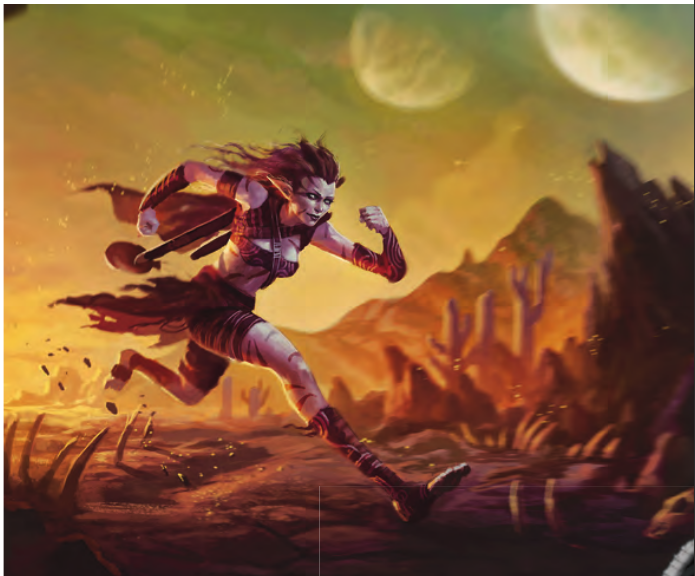
An elf running through the desert. Copyright 2010 Wizards of the Coast. This post is part of a series! Click here to see the rest.
The Lore
Athasian elves are tall and long-legged, and their culture is almost entirely nomadic. Elven communities roam the deserts of Athas accompanied by swift beasts of burden and war, but none of those are mounts. An elf will only accept being carried by a beast if they’re too sick or wounded to stand. Otherwise, they prefer to run. And they’re very good at it.
Unlike some of the other nomads we saw so far, such as brohgs, elves have frequent interactions with Athasian settled peoples and city states. Their overall reputation is not very good. They’re known as itinerant traders who bring a lot of cool stuff to sell in the Elven Markets many towns have, but they’re also known as swindlers, thieves, raiders, and occasionally murderers. The cool stuff they sell you was probably stolen from someone else, according to rumor.
This sort of reputation has a number of unplasant parallels with real-world prejudices, so I find it off-putting that the book spends a lot of effort trying to convince me it’s true. Even the PCs have “desert raider” and “market thief” as their new custom background options.
I’d prefer to portray elves as having a lot of solidarity for each other and not a lot of sympathy for the outsiders who hate them so much. They drive hard bargains at the Market and skip town en masse if it looks like someone’s going to accuse one of them of a crime. The accusation is likely to be false most of the time, as I interpret it. Some individuals might resemble the negative stereotype, but then again that’s also true of city-dwellers, whose negative stereotype is “servant to a slaving despot” or “slaver”.
Elves who are found guilty of crimes in their own communities are cast out, and will often end up joining groups of actual raiders and bandits.
The Numbers
Despite their taller build elves remain Medium Fey Humanoids with a ground speed of 7. The stat blocks here don’t have low-light vision, though I think that’s still a feature of PC elves. They do all have Wild Step and Elven Accuracy, which work like their PC versions too.
The level range here is roughly comparable to that of standard elves from other books, so you can mix-and-match a bit. All of the stat blocks here are Unaligned.
Elf Peddler
A typical denizen of the Elven Markets. This could both represent a more or less honest trader who knows how to defend themselves, or a cutthroat who looks for particularly vulnerable customers to ambush after a sale. It’s a Level 2 Skirmisher with the Leader tag and 34 HP.
A typical peddler’s goal in a fight will be to live to fight another day, so they always hang around places with convenient escape routes and obstacles that might deter pursuers, such as twisty alleys or clustered stalls.
The peddler is armed with a bone longsword, which does standard damage for its level. It can use the Double Dealing maneuver at will: this lets it make a sword attack, shift half their speed, and then make another sword attack against a different target if they end the shift flanking that target.
As a minor action they can also use Peddler’s Command, which lets an ally within 20 squares move half their speed as a free action. If that ally is another elf, the move is instead a shift. This is useful to set up the flank for that second Double Dealing attack.
Elf Sniper
Another typical denizen of the markets, Snipers work security from shadowy corners and rooftop perches. If trouble starts, they help cover their allies’ retreat with their thrown weapons.
Snipers are Level 3 Minion Lurkers armed with Bone Daggers and a brace of 10 Chatkchas, which are three-pronged sharpened boomerangs. Both of these attacks deal a bit of extra damage if the sniper is hidden from the target when they start the attack.
As an at-will Move action, the sniper can use Elven Misdirection to move 2 squares and make a free Stealth check to become hidden if they end the movement with cover or concealment. This check has an automatic result of 25, which means they “take 15” on the roll.
In combat, they’ll try to pop out from cover, make a ranged attack, and hide again. If someone tries to get close to them they will run. Like the peddler, their goal in a “market fight” situation is to delay and distract pursuers enough for their allies to flee, and then flee themselves.
Elf Dune Strider
This nomadic warrior is used to running through the wastes. This stat block can represent a raider, or someone who’s just protecting their wandering band. It’s a Level 4 Skirmisher with 52 HP.
The Dune Strider can Move Like the Wind, gaining +5 to all defenses against opportunity attacks provoked by movement. They’re armed with a Bone Longsword that does extra damage on a charge, and a Obsidian Shortsword that’s slightly better for static attacks. The Rushing Dervish maneuver lets them move their Speed + 2 and make one attack with each sword against a different target during the movement. This recharges when they’re bloodied.
Striders acting as raiders will keep mobile and try to spread out their attacks in an attempt to intimidate their targets into giving up their possessions. They will flee if the fight turns against them. Their traits and abilities make it easy for them to bounce around the battlefield like pinballs, making charge attacks.
Elf Raid Leader
The sort of veteran commander you might find leading a larger raid against a settlement, either as revenge for mistreatment or as a plain old resource grab. It’s level 6 Artillery with the Leader tag.
The leader has a obsidian shortsword for emergencies, whose strikes let it shift 1 square on a hit. It will mostly fight with its Bone Bow, which is both more accurate and more damaging. It can fire Harrying Shots that do the same damage as a basic ranged attack, but also make the target grant combat advantage to adjacent allies of the leader for a turn.
Its leaderly action is a command to Focus on the Pain (minor action, recharge 6+) which deals 5 damage to an ally within 20 squares and allows that ally to immediately roll a save with a +2 bonus.
Raid leaders obviously lead from the back, providing ranged support to their skirmisher and lurker allies. It might be good to add a brute or soldier war beast to help protect them.
Encounters and Final Impressions
I’ve already mentioned my opinion about the elven stereotypes here: I don’t like them, and would probably change them a bit were I to run a campaign in this setting. They would be less true than depicted in the book, and depending on the tone I was going for might or might not be less prevalent in the setting.
The stat blocks are good, and can make for an extremely mobile encounter group when used together. As mentioned above, any brutes and soldiers who are part of an all-elven group will likely be trained war beasts instead of more elves.
-
Let's Read the Dark Sun Creature Catalog: Eladrin
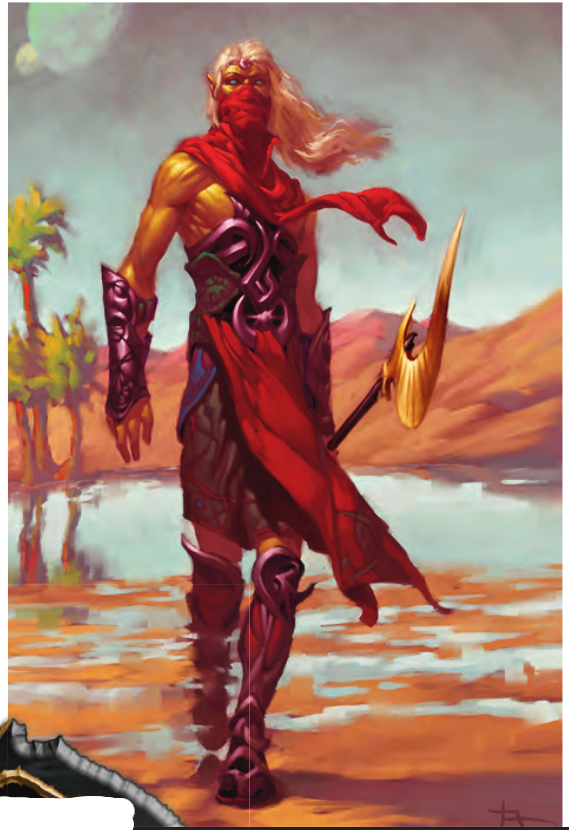
An Eladrin Veiled Warrior stepping out of a mirage. Copyright 2010 Wizards of the Coast. This post is part of a series! Click here to see the rest.
The Lore
Physically, Athasian eladrin are very similar to those of the core setting, but the near-total loss of their home plane has done a number on their psychology and culture.
Defiling magic didn’t just destroy Athasian ecosystems - they also dissolved its Feywild. Now only a few rare pocket dimensions remain, scattered like oases through the wastes. The fate of the Lands Within the Wind is still tied to that of Athas, which means they’re slowly dying just like the world is.
Similarly, Athasian Eladrin are a traumatized and dying people. Most of the ones that remain live in remote castles and settlements in the desert or inside surviving pockets of Feywild, guarding the entrance to their realms with psychic illusions and only venturing out when they must.
The Numbers
Eladrin have the same common stats as always: they’re Medium Fey Humanoids with a Speed of 6, Low-light vision and a +5 on saves vs. charm effects. They retain their signature Fey Step power, which lets them teleport 5 squares as a move action once per encounter.
These stat blocks occupies what would be the lower range of eladrin power levels from the Monster Manuals and Monster Vault. There are no more epic-level ghaeles and bralanis in Athas… probably.
Eladrin Veiled Warriors
Veiled Warriors are spies and scouts that range far away from Eladrin settlements to gather information and locate resources, thought hey can also be found as part of their homes’ defense force. This is a great origin for PCs!
NPC Veiled Warriors are Level 5 Soldiers with 60 HP. They fight with Reach 2 Longspears that damage and mark for a turn on a hit. Once per encounter they can use a Veiling Dart (ranged 5 vs. Will) which deals psychic damage, blinds for a turn and slows (save ends).
Eladrin Mirage Adept
These are the psions responsible for hiding Eladrin settlements. They’re Level 7 Controllers with 80 HP and a focus on illusion powers.
Their basic melee attack is a Dagger that deals psychic damage and slows for a turn. They can attack at range with Deluding Whispers (ranged 10 vs. Will), a charm power that deals psychic damage, slides 3 squares and prevents the target from seeing creatures not adjacent to it for a turn.
Occasionally they’ll strike with the Phantom Foes power (recharge 6, area 2 within 20 vs. Will), which I guess projects the illusion that many additional foes are attacking the targets. This “psychic fireball” deals psychic damage and confuses (save ends). Confused characters roll a d20 whenever they’re about to make a melee or ranged attack and an ally is also in reach of that attack. On a 10 or higher, they attack the ally instead of the intended target.
Mirage adepts are very effective when combined with veiled warriors, because the warriors use reach weapons and so don’t need to be adjacent to a target blinded by Deluding Whispers in order to attack.
Eladrin Windwalker
Some eladrin indiscriminately blame all people of the natural world for the fate of their homeland, and feel such overwhelming hatred towards them that they offer themselves in ritual sacrifice. This causes their life essence to slowly leak into the Feywild and be replaced with the raw magic of that plane. This gives them great power for as long as their diminishing life lasts. They use their remaining time to go out into the world and slay every humanoid they see.
Windwalkers are Level 8 Lurkers with 69 HP. They fight with sabers and blowguns that ignore armor and target Reflex. Their damage is average, but Unseen Advantage lets the windwalker deal extra damage against targets that can’t see it, and slow them for a turn on any hit.
The Between the Winds trait lets a windwalker become invisible and gain phasing whenever it either spends a turn without attacking or uses its fey step. These conditions last for a turn or until the windwalker attacks. This does mean they can stay continuously invisible if they don’t attack.
Windwalkers will usually try to attack every other turn like most lurkers to benefit from Unseen Advantage, but the presence of an ally who can make them invisible or blind PCs (like a Mirage Adept) can let them strike every turn with bonus damage.
Eladrin Windwalker Mirage
Windwalkers in the final stages of the process are little more than ghosts. They become Level 8 Minion Lurkers with a ground speed of zero, a flight speed of 6 (hover, altitude limit 2), always-on phasing, and Resist 10 All. Despite appearances they are not undead, and are not especially vulnerable to radiant damage and anti-undead powers.
Their Wisp on the Wind trait gives them partial concealment vs. enemies that are 2 or 3 squares away, and total concealment against enemies 4 or more squares away. Their melee attack is a Razor Wind that does minion-tier damage. When they hit 0 HP, their Dispersing Essence attacks a Close Burst 3 and does the same damage as Razor Wind to those it hits.
The mirage’s damage resistance means you can only get it to that point by dealing 11 or more damage with a single attack - they’ll resist anything weaker. On the bright side, this means Dispersing Essence cannot provoke a chain reaction as it only deals 8 damage.
Mirages love large battle maps that let them invisibly fly past the party’s defenders and gang up on isolated squishies. PCs can counter this tactic by sticking together, but Dispersing Essence makes that decision a bit tougher than it would seem at first. Cruel GMs can make it even harder by including other monsters capable of area attacks in the encounter.
Encounters and Final Impressions
The Windwalker variants are evil, having succumbed to genocidal rage, but everyone else is unaligned. And they’re all super tragic.
I don’t think windwalkers would mix with other eladrin, though it’s easy enough to reskin a standard Mirage Adept as another windwalker variant if you want to mix them up. As noted above, this makes for a potent combination.
-
Let's Read the Dark Sun Creature Catalog: Dune Reaper
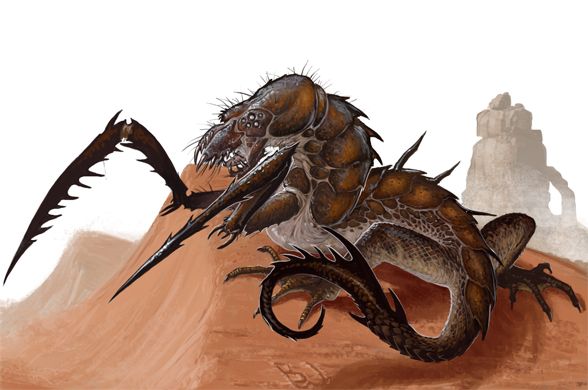
A dune reaper. This image is mirrored from the one in the book. Copyright 2010 Wizards of the Coast. This post is part of a series! Click here to see the rest.
The Lore
Like a lot of other Athasian fauna, dune reapers are predatory insectile/reptilian pack hunters. However, they lean a lot more towards the “insectile” side, and their origins are clearly unnatural even to contemporary inhabitants of Athas.
The book says they “came to existence through defiling magic”, though it doesn’t specify whether they were an artificially engineered species or whether some side effect of defiling brought them to the world. Their Aberrant origin kinda hints at the latter.
These creatures have a complex social structure. They organize into large familial groups known as prides, who build large hives from sand, rocks, and organic secretions near a water source that becomes the center of their territory. The pride then splits up into smaller packs, which roam that territory looking for food. A pack is composed of a large female “warrior”, accompanied by smaller male “drones” and “shrieks” who are her mates. The pride’s dominant female is known as its “matron”, and it’s her who makes decisions that affect the whole pack, like where to build the hive or when to seek new territory. A matron rules the pride until her death, which is usually in a duel with an up-and-coming warrior who challenges her for the position.
Dune reapers are a scourge on the local ecology. Their menu includes just about everything they can reach: humanoids, animals, plants, wagons, buildings… they even eat rocks to store in their gizzards and aid in the digestion of tougher food. A humanoid settlement in dune reaper territory is only safe if they can provide the creatures with an ample alternate source of food.
Dune reaper reproduction happens on an annual cycle, and they’re even more dangerous during mating season. The pride’s females need to lay their eggs inside the bodies of living creatures, you see. When the eggs hatch, the newborn reapers eat their host, and then set upon each other. Only the strongest hatchlings survive this process. After about two months they’re already as dangerous as a fully grown adult. At this time, they’re driven from their birth hive and must either join another pride or form a new one with other young reapers.
The Numbers
Dune Reapers are Aberrant Beasts with Darkvision. Their basic melee attack always uses their Arm Blades, which do standard damage for their level and might have other effects depending on the stat block.
Dune Reaper Drone
These relatively small males are Medium and make up the dune reaper worker caste. They build the hive and carry food back to it, but as Level 12 Skirmishers with 120 HP and Speed 8 they’re certainly strong enough to take part in the hunt as well.
Their basic arm blade attack also lets them shift 1 square on a hit. They can perform a Leaping Slash that lets them jump 4 squares without provoking opportunity attacks and use Arm Blade at the end of the movement. This recharges when they’re first bloodied.
If an enemy grants Combat Advantage to the drone, it can use a minor action to bite, dealing light physical damage on a hit. If an enemy makes a melee attack against the drone, it can Leap Away, jumping 4 squares without drawing OAs, as an immediate reaction.
Drones want to leap into melee at the start of the fight, and seek positions where their chosen target grants them CA. They’ll leap away when attacked and come back from an unexpected angle. When fighting drones, shoot them or surround them. Don’t let them surround you.
Dune Reaper Shriek
That’s not a role you usuall find among mundane insects. The book considers them specialized drones that can leap not just through the air, but through time and space. When they do this, they emit an ear-splitting scream that gives them their name. They’re Level 14 Lurkers with 106 HP and Speed 7.
Their arm blades are standard attacks with no riders, and are a lot more dangerous when used in conjunction with the shriek’s freaky powers. A Shrieking Reap lets them make two arm blade attacks against the same target. If one hits, it teleports the target 2 squares and inflicts 10 ongoing damage (save ends). If both hit, the teleport distance increases to 5, and the ongoing damage to 15. A Shrieking Warp removes the shriek from play until the start of its next turn, when it appears at a spot within 10 squares of its previous position and makes a Close Burst 2 attack that deals thunder damage and pushes 2 squares on a hit.
Shrieking Warp is an at-will ability, but it’s disabled for a turn when the shriek takes force damage because of its Forceful Silence trait. Shrieking Reap recharges whenever the creature uses Shrieking Warp. Our lurker loop here is Shrieking Reap -> Shrieking Warp -> Repeat.
The book reminds us that forced movement is always voluntary for the attacker, so shrieks arriving from a Warp will often choose to push all but one of the enemies they hit with the attack, to isolate it from its allies. Clever!
Dune Reaper Warrior
This Large female will lead a pack of drones and shrieks when hunting. She’s a Level 15 Brute with 180 HP, Speed 7, and the Leader tag.
She exudes an aura (3) of Inciting Pheromones that grants all dune reapers inside a +2 bonus to Will, and makes them immune to the Dazed condition. She also has the Unhindered trait we saw before, which lets her drag grabbed characters around when she moves.
Her arm blade is Reach 2 and extra-strong. She can perform a Leaping Slash similar to the drone’s, which also inflicts 10 ongoing damage if either attack hits.
Her triggered actions make her even more dangerous. Snapping Mandibles triggers when someone hits the warrior with a melee attack. As a reaction, she attacks their Fortitude and grabs them on a hit. Grabbed targets take 10 damage when they fail an escape attempt. Her Compelling Musk (recharge 5+) is triggered when she misses with an Arm Blade attack, and lets another dune reaper within 3 squares make a melee basic attack as an opportunity action. I’m not going to make a joke about that power name, it’s too easy.
Encounters and Final Impressions
Dune reaper packs number between 5 and 12 (!) individuals. Only one will be a warrior, though you could say the PCs found more than one pack together if you want there to be more of them.
Reapers are impossible to train, but sapient humanoids still capture them for use as arena beasts, and hunt them as a source of leather, organic armor plates, and blades.
These seem to me like yet another pack-based predator, the third or fourth we saw in this reading. I do like the ominous aberrant touches in both their lore and mechanics, though. The shriek in particular reminds me a lot of a Hound of Tindalos.
-
Let's Read the Dark Sun Creature Catalog: Dwarf
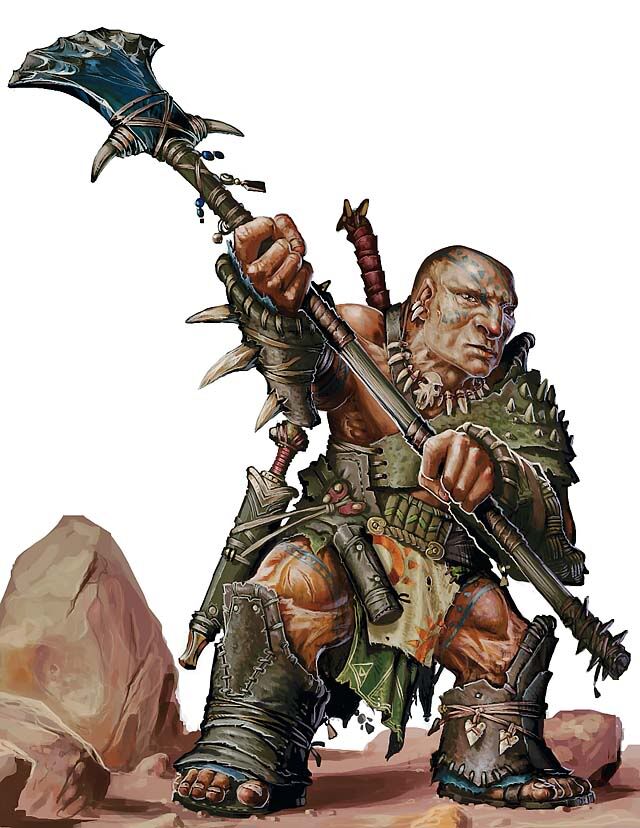
A Dark Sun dwarf. This world is too hot for big beards. Copyright 2010 Wizards of the Coast. This post is part of a series! Click here to see the rest.
It’s customary for Fourth Edition monster books to include entries for playable species. After all, they may show up as enemies or allies. In this book, they also serve to flesh out some of the Dark Sun-specific story of each species. As you can see from the illustration, dwarves here are a little different.
The Lore
Dwarves probably had a pretty typical culture in Athas’ distant past, as the book says they ruled “great mountain kingdoms”. However, the genocidal wars of the Red Age pretty much destroyed their civilization. While modern-day dwarves are still extremely resilient and dedicated workers, the knowledge of reading and writing the Dwarven language has been lost. While you can still find Davek runes in their ruins, no one alive knows how to read them.
The book kinda conflates this with dwarves not knowing how to read at all, and therefore not knowing any magic, but that’s a giant leap that I think is incorrect. Dwarven writing is a lost art, but Common and a lot of other languages still have written forms and magic lore doesn’t have to be encoded in Dwarven. I’d say dwarves are as likely to be literate and to know magic rituals as any other person in this setting.
True, when you’re talking about typical civilians that’s still not very likely, but Dwarven PCs and major NPCs will still be literate. And it does sound flavorful for modern dwarven culture to include an element of pride about not needing magic to do their work.
Dwarves are a fairly common people. Every city state has hundreds or thousands of dwarven laborers and artisans, both free and enslaved. They also live in small communities in the wastes, some of which are also mining camps. Whether your interaction with them is peaceful or violent depends entirely on the behavior of the PCs and on the objectives of that specific group.
The Numbers
Despite the differences, Athasian dwarves are still Medium Natural Humanoids with a ground speed of 5 and Low-Light Vision, just like the ones from the PHB. They retain the PC traits that make them hard to move: Stand the Ground and Steady-Footed, which reduce forced movement by 1 and let them roll a save against being knocked prone, respectively. They also have +5 to saves against poison.
Earlier editions spent a lot of time describing how each dwarf had an obsessive focus on one kind of task, to the point where it restricted their actions. That makes an appearance here but it’s not as dominant as before.
Dwarf Conscript
Technically a civilian, the conscript still has a body hardened by countless hours of heavy labor, and will not hesitate to pick up weapons in defense of their mine or their home. This is a Level 2 Brute with 47 HP, wearing hide armor and wielding a Dark Sun polearm known as a “gouge”, which is basically a sharpened shovel.
The gouge is a standard brute attack, but if it scores a critical hit it also pushes the target 1 square and knocks it prone.
The conscript also has a Singular Focus minor action that’s the last vestige of the 2e rules. This lets the conscript choose an enemy as the target of their focus, and gain +5 damage against that enemy while they remain the conscript’s focus.
The power recharges when the chosen enemy drops to 0 HP, and it lasts until the end of the encounter or until the conscript uses it again. It makes the conscript punch way above their weight class when attacking their chosen enemy, and is a very nice incentive to behave obsessively in a fight. Since they can only switch focus when the previous enemy dies, targeted enemies should keep away to make the conscript waste actions chasing them.
Dwarf Sunpriest
Modern dwarven religion venerates primal spirits and elementals, particularly those associated with the sun. Sun priests are venerated spiritual and political leaders among them, and often lead other dwarves into battle when necessary.
The Sunpriest is Level 5 Artillery with 52 HP and the Leader tag. They wear hide armor and wield a mace in one hand and a totem in the other. Their basic melee attack is a Burning Mace that deals fire damage, and their main ranged attack is a Bright Ray (ranged 10) that deals radiant damage and inflicts a -2 attack penalty on the target for a turn.
Once per encounter they can apply a Sun Blessing to an ally within 5 squares. That ally regains 10 HP, deals 5 extra fire damage with their attacks for a turn, and any enemy that hits them in the same time span takes 5 fire damage. Praise the sun!
Dwarf War Chief
Despite the name, not all war chiefs are commanders, but they’re all renowned champions. They’re Level 6 Elite Soldiers with 144 HP.
The war chief fights with a Greatclub made from giant bone, and its basic attacks grant them 5 temporary HP. Their Spinning Club maneuver (recharge 5+) attacks enemies in a Close Burst 1. If it hits an enemy marked by the war chief, that enemy is immobilized until the start of the warchief’s next turn.
And how do they mark enemies? Via Battlefield Focus, a minor action that lets them automatically mark up to 2 enemies within 10 squares. It recharges when one of these enemies drops to 0 HP.
If a marked enemy adjacent to the war chief moves, shifts, or makes an attack, Brutal Club gives the dwarf a basic attack against them as an interrupt, which also immobilizes for a turn on a hit. This triggers even if the enemy attacks the war chief, and even if the enemy makes one of those moves that doesn’t provoke opportunity attacks. This means it’s more powerful than a PC fighter’s Combat Challenge.
Encounters and Final Impressions
Dwarves can be part of any encounter group whose theme is “a bunch of people”, be they villainous, allied, or bystanders. Dwarven communities, like everyone else, also domesticate a number of Athasian beasts that might see use in a fight.
I like these stat blocks! They’re low-level but each has some very interesting tricks they can use. The “focus” powers ended up being more useful than I thought at first.
-
Let's Read the Dark Sun Creature Catalog: Drake
This post is part of a series! Click here to see the rest.
The Lore
Athas only has one dragon: The Dragon of Tyr. He’s the setting’s main bad guy, over and above the Sorcerer-Kings. As such, he’s immensely powerful, intelligent, and evil. Prime Final Boss material!
However, you might not want to wait until your PCs are level 30 demigods before they can fight a nasty giant lizard with elemental powers. That’s where Drakes come in.
Athas has a lot of things that would be called drakes in standard 4e, but here the name refers to something else entirely. The things Athasians call “Drakes” are, essentially, nonsapient dragons. They fulfill many of a dragon’s narrative functions. They’re big and tough enemies that make splendid boss fights for high-Paragon or low-Epic parties. There are several types associated with different elements. They lair in areas dominated by their associated element and possess psychic powers that let them summon and control orbs of that element from the Elemental Chaos. They even have a hoarding instinct!
The roles they don’t fulfill are those of being a Machiavellian plotter or a big player in regional politics, which are things you’d expect a powerful enough dragon to be. They’re animals, not people. A text box informs us drakes were written this way because the Dark Sun setting is very geographically limited, and has a relatively small number of movers-and-shakers who are all accounted for. Adding an arbitrary number of traditional sapient epic dragons to this mix would wreck the setting’s delicate equilibrium, and that’s a job for the PCs.
Another consequence of drakes not being sapient is that there’s no guarantee their hoards will be valuable. There might be some good loot there, but it’s going to be mixed with a mountain of trinkets and souvenirs that are merely shiny or pretty.
The Numbers
All drakes presented here are Huge Elemental Beasts with the Reptile tag, and a tag corresponding to their associated element. They all have a Bite and a Claw that act as basic attacks, and the signature Drake’s Fury power that lets them spend a single action to use two Claws against one target and a Bite against a different target.
Their elemental orb powers are area attacks that create a hazardous zone in the affected area, but their exact powers vary with each stat block. They always have a Bloodied Response reaction that lets them immediately rechage and use an elemental power when first bloodied.
The same text box that discusses why drakes are nonsapient tells us we can take any dragon from other books and add them as drakes in Athas by declaring them nonsapient. Good candidates include brown, gray and red dragons from the chromatics; adamantine, iron, and orium dragons from the metallics; and any of the catastrophic dragons. You might want to change the appearance of the metallics too, since their default coloration stands out too much.
Water Drake
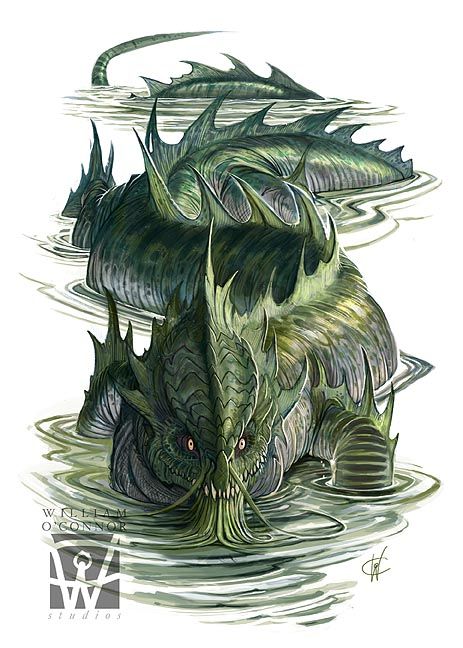
A water drake ready to ambush you from its oasis hideout. Copyright 2010 Wizards of the Coast. Water drakes like to lair in oases. A possible sign of their presence is the total absence of the small animals that usually live in such an environment. If you find such a place, you should either keep moving or be very, very sneaky when filling your waterskin.
This crocodile-looking beast is a Level 18 Solo Controller with 680 HP. It has Resist 10 Cold, a ground speed of 8, and a swim speed of 12. It’s Aquatic, meaning it can breathe underwater and gets +2 to attacks against non-aquatic creatures in underwater combat.
The drake’s elemental attack is an Orb of Elemental Water, which is a fireball-sized area attack (area 2 within 10, recharge 5+). It comes in two versions:
-
The boiling orb deals fire damage despite being made of water, and creates a damaging zone that lasts for the rest of the encounter or until the drake uses another boiling orb.
-
The ice orb deals no immediate damage, but inflicts ongoing 20 cold damage and restrains (save ends both). It creates a zone that repeats the orb’s attack against any creatures start their turn in the zone and are not restrained. Again, this lasts until the end of the encounter or until the drake uses another ice orb.
Yes, this means the drake can have both a boiling and a frozen zone in place simultaneously, though I’d rule they can’t overlap.
The drake’s other power is Psionic Clone (minor action, recharge 4+), which lets it create a duplicate of itself on a solid or liquid adjacent space in the map. The copy can acts independently and can take a full turn on an initiative count 10 lower than the original’s. It has all the original’s stats and powers with the following exceptions: it only has 1 HP; and it shares the original’s recharge roll for its powers instead of having its own. If the original has any spent powers when it uses this power, the copy’s powers will also start out spent.
The water drake’s Bloodied Response recharges both the Orb and Psionic Clone, letting the drake use both as a free action right then and there. Double the orbs, double the fun.
Fire Drake
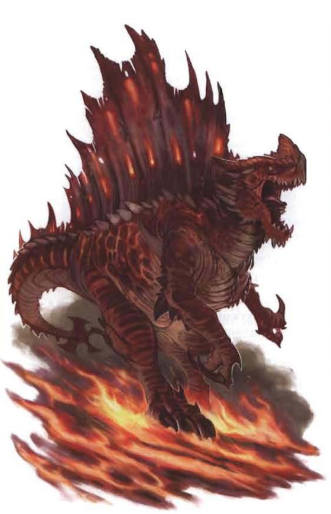
A fire drake roaring atop a patch of flaming ground. Copyright 2010 Wizards of the Coast. The flavor text here has a fire drake living inside an active volcano and worshipped as a god by a halfling tribe, who try to sacrifice a human to it only to be eaten along with the intended victim. Cliches aside, this shows us you can find fire drakes in volcanos and other such places.
Fire drakes are Level 20 Elite Lurkers with 298 HP, a Speed of 9, and Resist 15 Fire.
The drake’s bite does standard damage for its level. The claw is a little weaker but grabs on a hit. Drake’s Fury works as normal.
The creature’s Orb of Elemental Fire (recharge 5+) is an Area Burst 1 within 10 that deals fire damage and creates a damaging fire zone that lasts until the end of the encounter or until the drake casts another orb. While it waits for the power to recharge, it can use minor actions to move the existing magma zone 4 squares. The drake’s Bloodied Response recharges this orb and lets the beast use it immediately.
The fire drake’s last power is not elemental: it’s Living Shield, an opportunity action that lets the beast use a grabbed victim as a shield if anyone other than that victim damages it. This makes the victim take half of the attack’s damage, with the other half still affecting the drake.
There’s nothing terribly lurkery about the fire drake. With that grab and the mobile zone, you could have made it a controller instead.
Air Drake
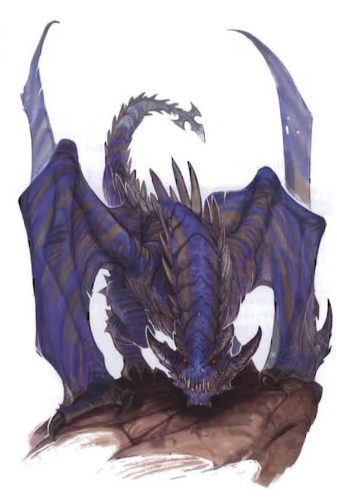
An air drake in a menacing stance. Copyright 2010 Wizards of the Coast. Air drakes live in tall mountains and canyons. They love to hunt animals and people who try to walk the precarious passes of these places, knocking them down with their wind powers and devouring the tenderized remains. They’re Level 22 Elite Skirmishers with 404 HP, a ground speed of 8, and a flight speed of 10.
These creatures deal extra damage when they have CA on an enemy, and this bonus increases when they’re bloodied. Their physical attacks are otherwise pretty standard for a drake.
Their Orb of Elemental Air has a wider radius than usual (area burst 3 within 10), and deals untyped damage on a hit. On a hit it also slides the targets 5 squares, and creates the usual damaging zone. The zone cannot be moved, but slides targets 3 squares when it damages them. This recharges when the drake is first bloodied, but it has to be used during the drake’s actions after this.
When pressured, the drake can use Wind Veil as a minor action (recharge 4+). This lets it shift its speed and gain concealment against non-adjacent enemies until the end of its next turn. Bloodied Response recharges this, and lets the creature use it immediately.
It felt odd for Bloodied Response to be such a defensive power here… but then I saw that it’s because the drake can use Control the Wind as a reaction when damaged. This is a Close Burst 5 vs. AC that deals the same damage as the bite to the triggering enemy, and lets the monster slide the target 3 squares. Exceptionally, this slide can be vertical, which means the target will take a bit of fall damage when it falls back to the ground… or a lot of fall damage if tossed diagonally into a chasm. A merciful GM could probably still allow the usual save vs. hazardous terrain to let the victim cling to an edge before being tossed.
Earth Drake

An earth drake. Copyright 2010 Wizards of the Coast. A spicy bullette with earth control powers. Earth Drakes are Level 24 Elite Controllers with 456 HP, a ground speed of 8, and a burrow speed of 6.
Their physical attaks work as usual. Their Orb of Elemental Earth is an Area 1 within 10 attack vs. Fortitude. It damages and restrains (save ends) on a hit, deals half damage on a miss.
The resulting zone is difficult terrain, and the drake can use minor actions to make secondary attacks against anyone inside. This deals a tiny bit of physical damage and knocks the target prone. This is what Bloodied Response recharges, but it’s not the only thing that happens when the earth drake is bloodied.
You see, when that happens the drake Expands. It goes from Huge to Gargantuan, pushing any targets that were adjacent to it out of its new occupied space. While this lasts (until the end of the drake’s next turn), the drake’s melee reach improves from 3 to 4, it gains +2 to AC, and anyone hit by its attacks is immobilized.
When someone damages the drake it can use Immovable Stone as a reaction, ignoring up to 4 squares of forced movement and using its bite against the attacker.
Encounter and Final Impressions
Since Athasian Drakes lack sapience, it’s harder to justify them being accompanied by minions. However, all but the Water Drake are elites, which means it’s very easy to set up an encounter against a mated pair of them. It might also be possible to add elementals of an appropriate level to any drake encounter as extra minions or regulars. The beasts wouldn’t be interested in eating them.
Overall I like their mechanics. Taking one of these drakes and turning them into a sapient dragon for outside of Dark Sun is as easy as taking a foreign dragon and turning it into an Athasian Drake.
-
subscribe via RSS